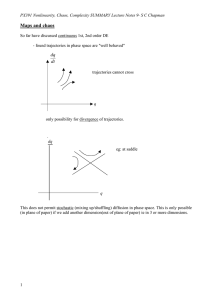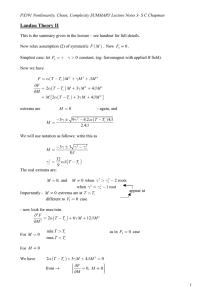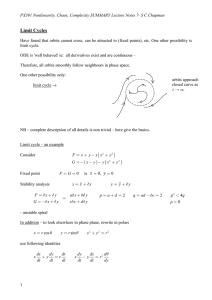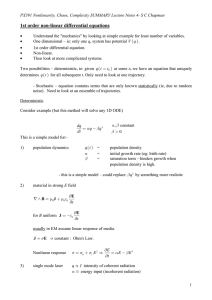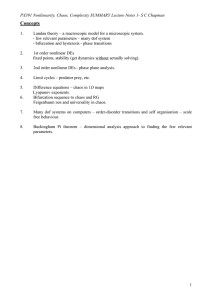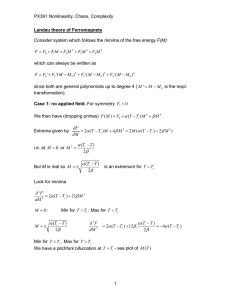( ) Twice iterated tent map : find corresponding map
advertisement
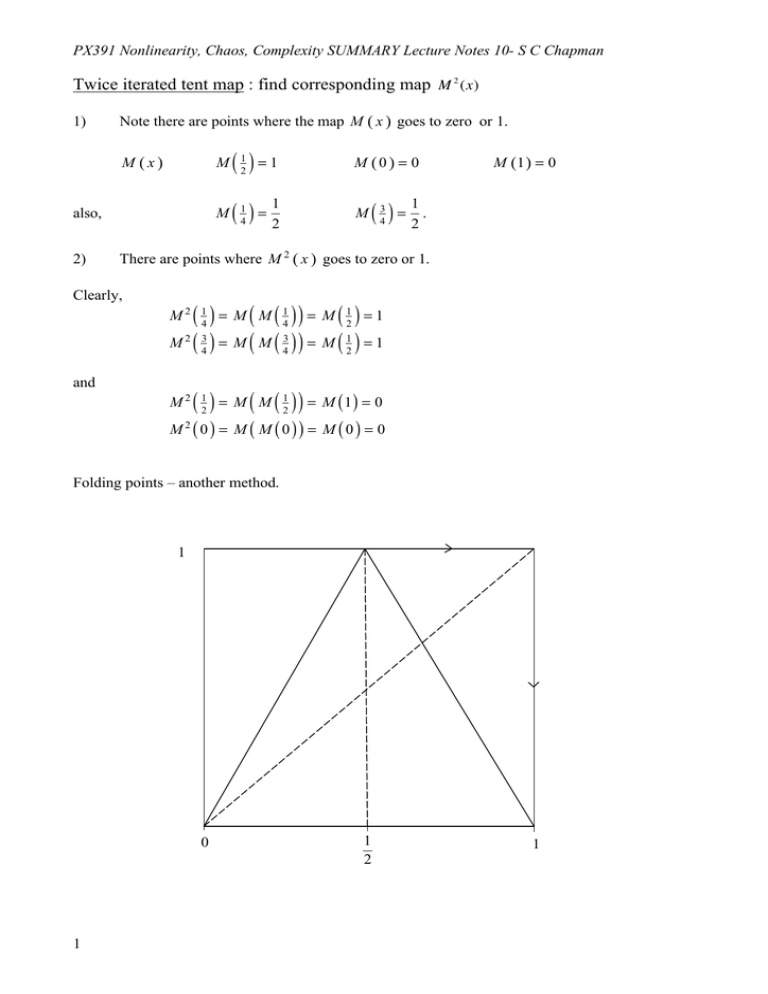
PX391 Nonlinearity, Chaos, Complexity SUMMARY Lecture Notes 10- S C Chapman Twice iterated tent map : find corresponding map M 2 (x) 1) Note there are points where the map M ( x ) goes to zero or 1. M (x) also, 2) M ( )=1 M (0) = 0 M ( ) = 12 M 1 2 1 4 M (1 ) = 0 ( ) = 12 . 3 4 There are points where M 2 ( x ) goes to zero or 1. Clearly, M2 ( ) = M ( M ( )) = M ( ) = 1 ( ) = M ( M ( )) = M ( ) = 1 M2 ( ) = M ( M ( ) ) = M ( 1) = 0 M2 and 1 4 3 4 1 2 1 4 3 4 1 2 1 2 1 2 M2 (0) = M ( M (0)) = M (0) = 0 Folding points – another method. 1 0 1 1 2 1 PX391 Nonlinearity, Chaos, Complexity SUMMARY Lecture Notes 10- S C Chapman M2( x) = 1 1 2 M (x) = 1 4 1 iterates as M 4 1 iterates as M 8 1 iterates as M 16 ( ) = 12 1 4 M2 1 2 ( )=1 1 4 ( ) = 14 and M ( ) = 14 so similarly 1 8 1 16 M5 Now consider all the segments between, ie 1 1 1 1 3 3 0! , ! , ! , ! 1. 4 4 2 2 4 4 2 ( )=0 1 4 M2 1 4 M3(x) = 0 3 4 M3 ( ) = 12 1 2 ( )=1 1 4 ( )=0 1 16 so M 4 ( )=0 1 8 PX391 Nonlinearity, Chaos, Complexity SUMMARY Lecture Notes 10- S C Chapman Notation Write M ( x ) as M < ( x ) = 2x "left half" M> ( x ) = 2(1 ! x ) 1 2 1 4 1 2 1% ( 4 '& 1% " $0 ! 2 ' # & 0 " $0 ! # " $0 ! # Clearly, and only need 0!x! 1 4 1% ( [ 0 ! 1] 2 '& 3 4 M< ( x ) M< ( x ) M < ( x ) here M 2 ( x ) = M <2 ( x ) Now "1 1% "1 % $ 4 ! 2 ' ( $ 2 ! 1' # & # & "1 % $ 2 ! 1' ( [1 ! 0 ] # & M< ( x ) M> ( x ) so, 1 1 !x! 4 2 M 2 ( x ) = M> ( M< ( x ) ) similarly 3 1 "right half" PX391 Nonlinearity, Chaos, Complexity SUMMARY Lecture Notes 10- S C Chapman 1 3 !x! 2 4 3 ! x !1 4 M 2 ( x ) = M >2 ( x ) M 2 ( x ) = M< ( M> ( x ) ) Then plug in M < , M > to get the result. 1 M 2 ( x ) = 2 [ 2x ] = 4x 4 1 1 !x! M 2 ( x ) = 2 ( 1 " [ 2x ] ) = 2 " 4x 4 2 1 3 !x! M 2 ( x ) = 2(1 " [ 2(1 " x ) ] ) 2 4 = 2 ( 1 " 2 + 2x ) 0!x! = 4x " 2 3 ! x ! 1 M 2 ( x ) = 2[ 2 ( 1 " x ) ] 4 = 4 " 4x Sketch M 1/4 1/4 1/2 1/2 x 3/4 3/4 x Note – neighbouring points on x move apart as length of M ( x ) line increases as we iterate – stretch/fold. 4 PX391 Nonlinearity, Chaos, Complexity SUMMARY Lecture Notes 10- S C Chapman 1 triangle 2 fixed points • 1/2 M2 2 triangles 4 fixed points • • • • • 1/2 1/4 M3 • • • • • • • • 5 1/8 1/4 4 triangles 8 fixed points PX391 Nonlinearity, Chaos, Complexity SUMMARY Lecture Notes 10- S C Chapman p th iterate of map 2 p !1 triangles 2 p fixed points 2! p 2! p +1 - base length Therefore, any points in x separated by more than 2! p can be anywhere in [ 0, 1 ] after p iterates. - chaos follows from inevitability of map. Note, gradient is always 2 p > 1 therefore, always globally unstable. 6 PX391 Nonlinearity, Chaos, Complexity SUMMARY Lecture Notes 10- S C Chapman local gradient and stability Note that this shows if a fixed point is unstable. eg: tent map xn +1 = 2 xn , xn +1 = 2 (1 ! xn ) xn +1 = xn M • • x1 unstable stability just depends on gradient locally 2 x1 x0 x here gradient > 1 M 1 2 here gradient < stable 1x 7 PX391 Nonlinearity, Chaos, Complexity SUMMARY Lecture Notes 10- S C Chapman Mathematically, for some map M ( x ) consider small displacement ! xn from fixed point x and Taylor expand xn+1 = M ( xn ) at xn = x + ! xn . xn+1 = M ( x + ! xn ) ! M ( x ) + ! xn but xn+1 = x + ! xn+1 so x + ! xn+1 = x + ! xn ( ) dM dM x ) + 0 ! x 2 ! x + ! xn ( (x) dx dx dM (x) dx ie: ! xn+1 dM = (x ). ! xn dx dM ( x ) < 1. dx Must hold for all iterates.. Lyapunov exponents So, for stability Measure of divergence of trajectories. Lyapunov exponents (or Lyapunov number) Consider a general map xn+1 = f ( xn ) how fast are two initially neighbouring points converging/diverging? Have initial condition x0 . This then has iterates x1 , x2 ...xn x1 = f ( x0 ) , x2 = f ( x1 ) , etc. Consider an initially neighbouring point x!0 = x0 + ! 0 separated from x0 by ! 0 ! 1 . After we iterate x!1 = f ( x!0 ) = f ( x0 + ! 0 ) = f ( x0 ) + ! 0 But, after one iterate x!1 = x1 + !1 then df ( x ) + ... , by Taylor expansion. dx 0 Now two points are separated by !1 df ( x ) + ... dx 0 to first order in ! 0 . x!1 = x1 + !1 = f ( x0 + ! 0 ) = f ( x0 ) + ! 0 ie: !1 = ! 0 f " ( x0 ) So, generally for j th iterate have x! j = x j + ! j 8 ( ! j = ! j"1 f # x j"1 ) PX391 Nonlinearity, Chaos, Complexity SUMMARY Lecture Notes 10- S C Chapman provided ! j ! 1 0 < j < n . x!n = xn + ! n = xn + ! n"1 f # ( xn"1 ) = xn + ! n"2 f # ( xn"2 ) f # ( xn"1 ) Then = xn + ! 0 f # ( x0 ) f # ( x1 ) ... f # ( xn"1 ) x!n+1 = xn+1 + ! 0 f " ( x0 ) ... f " ( xn ) n ( ) x!n+1 = xn+1 + ! 0 " f # x j j=0 Now use a trick (handy to turn a product into a sum) ( ) f ! xj = e ( ). ln f ! n j ( ) (and we don't need to know – just interested in In addition, we do not know the signs of all f ! x j whether the product is getting bigger or not in magnitude). So, write % n#1 ( x!n = xn + ! 0 exp ' $ ln f " x j * , & j=0 ) and hence, define Lyapunov number (exponent) ( ) n%1 != NB: after written with n!1! n n"# ( ) 1 & ln f $ x j Lim n j=0 n"# which is a measure of exponential divergence of trajectories x!n ! xn = " 0 en# . What about approximation ! j ! 1 ? Can always take ! 0 (and thus ! j ) infinitesimally small – still same dynamics. So !<0 !>0 - x is at an attractor – trajectories converge. x is at a repellor → chaos trajectories diverge. Note, there is a ! for each degree of freedom (coordinate) here one (x). ( ) Note that generally if all f ! x j 9 >1 all iterates PX391 Nonlinearity, Chaos, Complexity SUMMARY Lecture Notes 10- S C Chapman ( ) ln f ! x j then all " ln f ! ( x j ) then >0 >0 and ! > 0 chaotic ( ) Similarly, if all f ! x j <1 then all ln f ! x j <0 !<0 and * ( ) - stable attractor - if our graphical result that for each iterate if gradient > 1 unstable - now generalised this for all iterates of the map – characterised the dynamics. * Tent map after p iterates: gradient = ±2 p gradient > 2 ! p+1 * Therefore, tent map globally chaotic * Next, consider polynomial maps. More complicated f ! ( x ) 10 all iterates
